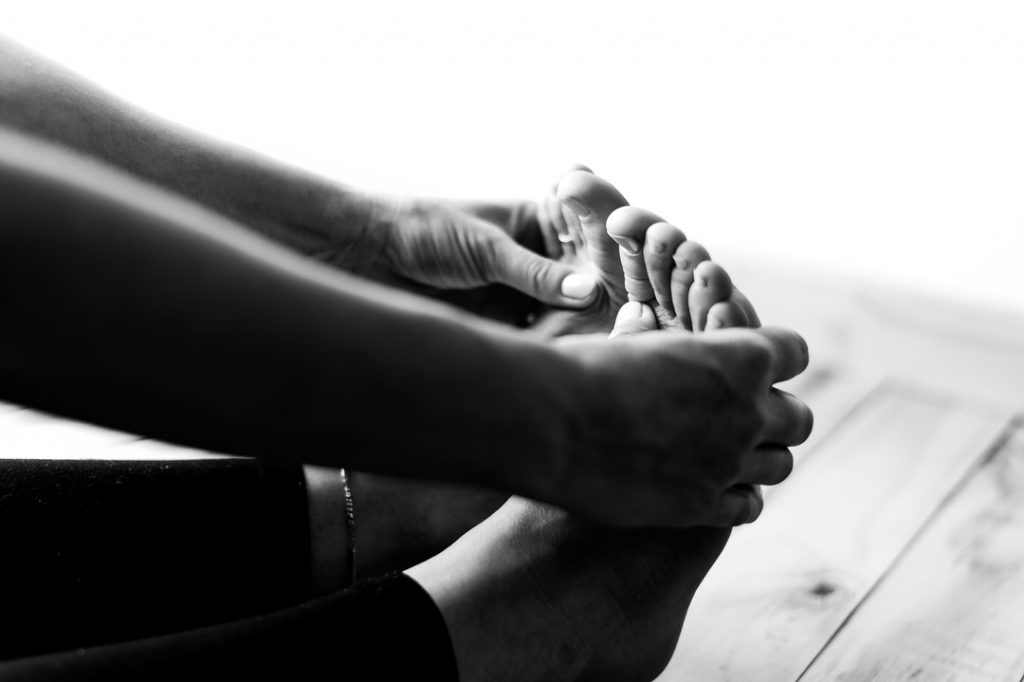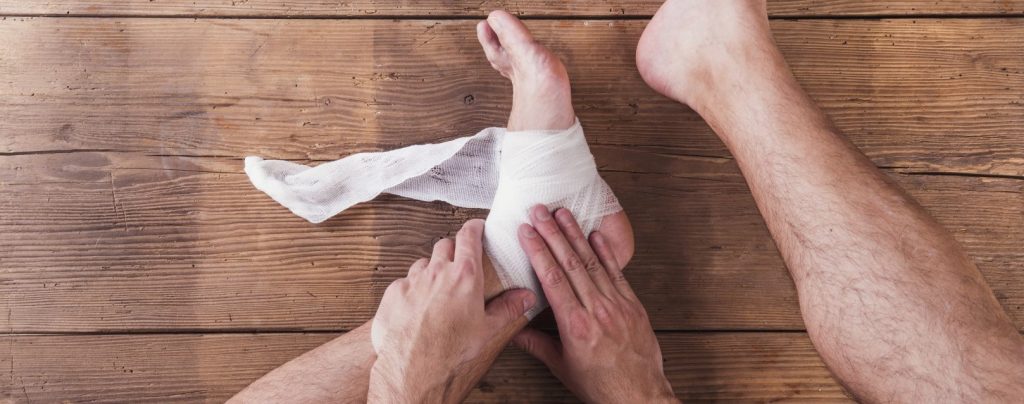What is Retrocalcaneal Bursitis?
Retrocalcaneal bursitis is a medical condition that occurs when the bursa located around the heel of the foot experiences inflammation. This can be debilitating, causing pain, swelling, and limited movement.

What is the Bursa?
Bursa are small sacs that surround the joints and are filled with fluid. These are near the heels of the feet, immediately behind the Achilles tendon. They are right above where this tendon attaches to the bone of the heel. It is so close to the Achilles tendon that retrocalcaneal bursitis is often mistakenly diagnosed by medical professionals as Achilles’ tendonitis.
What are the Symptoms Associated with Retrocalcaneal Bursitis?
There are many symptoms of retrocalcaneal bursitis, with the most common being pain in the heel. This may only be experienced when pressure is placed immediately on this area of the foot. The following outlines other symptoms of retrocalcaneal bursitis:
- Swelling near the back area of the heels
- Pain when you lean back and put pressure on the heels
- Pain within the muscles of the lower legs
- Stiffness in the foot and around the ankle
- Skin that is warm to the touch and red on the back area of the heel
- The inability to appropriately move the foot
- A cracking sound and/or sensation when engaging in foot flexing
- Wearing shoes may prove to be uncomfortable
What Causes Retrocalcaneal Bursitis?
Retrocalcaneal bursitis is typically caused by overuse of the heel and ankle. In addition to this, not warming up prior to engaging in exercises, quickly engaging in physical activity, poor-fitting shoes, and wearing high heels may result in the onset of this condition. Other causes include:
- Arthritis
- Haglund’s Deformity
- Being over the age of 65
- Work that results in repetitive movements and/or stress on the joints
- Participating in sports
- Tight muscles
- Infection (Rare)
How Do You Treat Retrocalcaneal Bursitis?

Retrocalcaneal bursitis is treated in numerous ways. A doctor may recommend the use of custom heel wedges and/or a steroid injection.
Rare cases may require surgery to completely remove the bursa; however, physical therapy is often the ideal treatment for retrocalcaneal bursitis. This is due to the fact that physical therapy helps in strengthening the heel and the ankle, which can aid in optimizing mobility.
Physical Therapy, elevating the feet, resting the feet, icing the area, over-the-counter medications for inflammation, and wearing a shoe that is designed with an elevated heel are all effective treatments for retrocalcaneal bursitis.
What are Some Retrocalcaneal Bursitis Treatment Exercises?
Heel Bursitis Physical therapy includes several exercises for your foot or ankle bursitis that may be used in conjunction with at-home treatment measures to assist in the quick healing of this often highly painful medical condition.
In most instances, physical therapy professionals recommend rest and icing the heel and surrounding areas for the relief of the symptoms of retrocalcaneal bursitis. Rehabilitation exercises – such as those issued by physical therapists – are highly recommended.
Generally speaking, it is advised to engage in stretching of the heal. This aids in optimizing the flexibility of the area and helps to alleviate any and all impingements on the bursa, which naturally relieves symptoms of the condition.
When engaging in these exercises, a gradual increase should be done in order to revert back to the level of functioning prior to the development of the issue in a pain-free manner.

Best Retrocalcaneal Bursitis Treatment Exercises
When starting an exercise regimen for retrocalcaneal bursitis, it is imperative to remember that a warm-up should always be performed. Stretches for Heel Bursitis are often recommended. As time progresses, you may then increase the intensity and the overall frequency of the exercise program to recover from the condition. The following outlines the best retrocalcaneal bursitis treatment exercises:
- Achilles Tendon Stretch – Stand with no shoes on and put your toes up against the wall, with the knees bent slightly. Move towards the wall until you feel a stretching sensation in the bottom of the foot and in the heel. Hold it for 30 seconds. Then, move to the next leg. Do 3 reps per leg for the best results.
- Flat Surface Heel Lift – Stand up on a flat surface, while holding on to a sturdy item (such as a chair). Then, lift up on the toes with each of your legs. Move the weight of your body on one of the legs and slowly go back down to the floor. You should do 3 sets of a total of 15 reps.
- Bent Knee Heel Lift – Stand in such a way that the feet are slightly apart. The toes should be pointed straight. Bend the knees and move them forward so that the ankle is bent as much as possible. Raise the heels and stand on the toes. Hold the position for just a few seconds. Then, lower the heels to the floor. You should perform 5 reps.
What Other Treatments Are Available?
There are many treatments available for retrocalcaneal bursitis. These include the following:
- Taping the heel to help in the stabilization and decompression of the area that is experiencing pain for a period up to 7 days.
- Non-steroidal anti-inflammatory medications such as ibuprofen and naproxen may help with pain and inflammation. There are topical NSAIDS that may help, too.
- Corticosteroid injections may be utilized to reduce the pain associated with retrocalcaneal bursitis.
- Open-backed shoes may be worn to alleviate pressure placed on the heel.
- While rare, there are surgical interventions that may be used to help individuals with severe cases of retrocalcaneal bursitis.
- Physical therapy may be used to treat the condition and is often considered to be the most effective treatment.
Bursitis Foot Cortisone Injections
A bursitis foot cortisone injection is a specially-designed treatment measure that provides short-term pain relief by reducing inflammation of the soft tissues of the foot; specifically, the bursa.
What is Cortisone?
Cortisone is an anti-inflammatory-based medication that is utilized to treat a wide array of musculoskeletal conditions. It is a synthetic type of cortisol, which is a hormone that occurs in a natural manner in the body. Cortisol is released naturally within the body to respond to stress.
What Happens Once I Receive the Bursitis Foot Cortisone Injection?
The synthetic cortisone is combined with a local anesthetic and injected in or around a specific area of the body – such as the bursa region. Once the mixture enters the body, it helps to reduce the amount of pain that you are experiencing, reduce any inflammation, eliminate the accumulation of fluid, and may work to thin out any adhesions or present scar tissue in and around the region.
Given that the injection may be painful upon initiation, many professionals will administer the anesthesia separately to ensure a higher level of comfort prior to the bursitis foot cortisone injection.
Are There Different Types of Cortisone Injections for Bursitis?
Yes, there are different types of cortisone. Most doctors will administer those that are considered “long-duration”, which means that they take effect within one to three weeks and the benefits actually last up to nine months. Most clinicians go with a standard rule that no more than three different injections should be used in one area of the body within a twelve-month period.
Benefits of Bursitis Foot Cortisone Injections
If there is an immense amount of pain and lifestyle remedies have not corrected the issue, a bursitis foot cortisone injection will help in reducing pain and inflammation. Often, these may be given in conjunction with physical therapy services to increase the strength and mobility of the foot.
What is the Recovery Time for Heel Bursitis?

The recovery time for heel bursitis may range from a few days to several months, depending on the overall severity of the issue.
How Do I Know if I Have Heel Bursitis?
If you have pain at the back area of the heel, you may have heel bursitis. The pain typically increases with walking and running. If the area is touched, it may be painful. You may find that your heel region hurts if you stand on the tip toes. The back of the heel may become warm, red, and swollen. The pain may be mild; however, it could range from moderate to severe pain.
How Long Does Heel Bursitis Last, Usually?
In most instances, heel bursitis lasts about eight weeks and improves with home treatment and physical therapy. Immediately after resting and icing, you should attempt to resume low-impact physical activities. You should consult with a doctor when you want to start new exercises. In most instances, it is best to work with a physical therapist. These professionals will customize an exercise program that will work best for your individual needs.
What Helps Heel Bursitis Recovery Time?
There are many steps you may take to help heel bursitis recovery time. First, you should rest your foot in the initial stages of the condition and elevate often. You may also use ice to help alleviate the swelling and the pain.
Once the heel starts healing, low-impact physical activities may be pursued. You should consult with a physical therapist for a customized exercise plan that meets your individual needs. At first, you should work under the immediate supervision of a physical therapist. As time progresses, you will be able to work more independently.
